User:Heritagefutures
Contents
- 1 Collection Interests (eclectic)
- 2 Websites
- 3 TO DO
- 4 Resources
- 5 MY SANDBOX
- 6 PAGE ONE -- MAIN ENTRY FOR MAMIYA-SIX
- 7 History
- 8 Patent Applications
- 9 Notes
- 10 PAGE THREE -- Mamiya Six II
- 11 Mamiya Six IIa
- 12 Brochures and Manuals
- 13 Notes
- 14 PAGE FIVE -- Mamiya Six IV
- 15 PAGE SIX -- Mamiya Six V
- 16 Notes
- 17 PAGE SEVEN -- Mamiya Six K
- 18 Notes
- 19 PAGE EIGHT -- Mamiya Six IVb
- 20 Notes
- 21 PAGE NINE -- Mamiya Six Automat
- 22 Patent Application
- 23 Notes
- 24 PAGE TEN -- Mamiya Six K2
- 25 Notes
- 26 PAGE ELEVEN -- Mamiya Six IVs
- 27 Notes
- 28 PAGE TWELVE -- Mamiya Six P
- 29 Notes
- 30 PAGE THIRTEEN -- Mamiya Six Automat 2
- 31 Notes
Collection Interests (eclectic)
- Simmon-Omega/Koni-Omega family of cameras
- Japanese aerial and other military cameras
- Foth & Co cameras and binoculars
- → Foth Derby
- → Foth-Flex
- Konica model I cameras (variants)
- Cameras with Gitzo Shutters and Gitzo gear (older stuff preferred)
- Konishiroku and Rokuoh-sha (not systematic)
- Mamiya Six cameras (variants)
Websites
TO DO
Photograph:
- door catches of the two Six III versions
- door shape of the two Six III versions
WIP
Resources
| START : How many viewfinder windows are on the front? |
TWO Windows
|
THREE Windows
|
six-pane documentation

|

|

|

|

|

|
| Mamiya Six Model XXXXXX. Images by Dirk HR Spennemann. (Image rights) | ||
| DIRECTIONS WHAT"S TO BE SEEN | |
|
ADDITIONAL TEXT OR ILLUSTRATIONS GO HERE | |
right float image

|
| CAPTION CAPTION CAPTION Image by Dirk HR Spennemann. (Image rights) (Image rights) |
MY SANDBOX
Mamiya 50th Anniversary FN [1]
PAGE ONE -- MAIN ENTRY FOR MAMIYA-SIX
This article is about the spring-folder camera made by Mamiya in the 1940s and 50s. For the 1990s camera, see Mamiya 6.
The Mamiya Six is a series of 6×6 folders with a coupled rangefinder, made by Mamiya from 1940 to the 1950s. All of them are focused by moving the film plane, rather than the more common front-cell focussing of other folders of the time.
History
The brain behind the development of the Mamiya Six was the inventor Seiichi Mamiya. His camera design departed from the common method of front cell focussing. In order to be able to control the camera when looking through the rangefinder while maintaining a steady hold,[2] he designed a method that allowed the film plane to move in relation to the lens. He filed his invention on 1 July 1939 in Japan[3], on ¶¶ 1940 in the United Kingdom[4] and on 5 June 1940 in the U.S.A. The U.S. Patent (nº 2,305,301) was granted on 15 December 1942, but, because of the state of war between the USA and Japan, was vested in the Alien Property Custodian.[5]
Evolution

|
| Prototpye of the Mamiya Six Image in Asahi Camera (アサヒカメラ) July 1951, p. 88 Scanned by rebollo_fr. (Image rights) |
The first model (Mamiya Six I) was advertised in September 1940 and first went on sale in December 1940. Until the end of the World War II, the Mamiya Six was significantly modified at least three times: first in early 1941 (model Ia) with two additional improved models introduced in the next two years. Erratically, model III was released in 1942[6] before model II appeared in 1943. All pre-war and war-time models have a twin set of range finder windows as well as a small, seperate Brillant-type waist-level viewfinder, resulting in three windows at the front. All units have a single red film frame counter window counter on the back with a horizontal slider opening to the left. The Mamiya Six III added an exposure counter with double exposure prevention. The pre-war and war-time models were all 6x6 format cameras.
Production of the Mamiya Six was restarted after World War II. The first cameras to be sold were Mamiya Six III. It is not clear to what extent these units were assembled from existing spare parts, or whether all are totally new construction. The official Mamiya history states that ¶¶¶ These post-War Mamiya Six III were fitted with which was introduced in Takatiho Tokio Zuiko f/3.5 75mm lenses, which debuted in 1946.[7] The first new model to appear was the Mamiya Six IV, introduced in 1947, which dispensed with the waist-level finder. It remained the sole model until 1953. The Mamiya Six V added the dual 6×6 and 4.5×6 format capability, with an exposure counter functioning with both formats. The Mamiya Six K was a simpler model, with film advance via red windows.
In 1955, the Mamiya Six IVb introduced a squarer body design, easily recognized by the square rangefinder window. Its features were similar to the model IV. The Mamiya Six K2 was similar to the model K with the new body. The body design was slightly modified again for the Mamiya Six IVs and simpler Mamiya Six P.
From 1955, the Mamiya Six Automat and the later Automat 2 added a coupling between the shutter cocking and the film advance.
Chronology of Models
Given the quite erratic nature of model numbering that occurred over the years, the chronology of the thirteen major Mamiya Six models is set out in Table 1. The characteristcs of the individual models, as well as the variants within these models, are described further below. If in doubt about some of the features mentioned in the type descriptions, please refer to the visual documentation of the critical elements which provides a dichotomous key as well as a series of illustrations showing the model-specific details.
Table 1 Chronology of Mamiya Six Cameras
| Release Date | Model/Variant | |
| pre-War Production | 1940, September | Mamiya Six I |
| 1941, January |
Mamiya Six Ia | |
| War Production | 1942, January | Mamiya Six III |
| 1943 | Mamiya Six II | |
| 1943? | Mamiya Six IIa | |
| 1945 |
Production Ceased | |
| post-War Production | 1946, November | Mamiya Six III |
| 1947 | Mamiya Six IV | |
| 1953, November | Mamiya Six V | |
| 1954, August | Mamiya Six K | |
| 1955, May | Mamiya Six IVb | |
| 1955, December | Mamiya Six Automat | |
| 1956, March | Mamiya Six K2 | |
| 1957, October | Mamiya Six IVs | |
| 1957, December | Mamiya Six P | |
| 1958 | Mamiya Six Automat 2 |
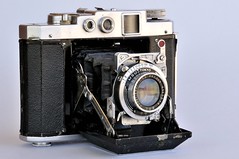 Mamiya Six I |
Mamiya Six Ia |
 Mamiya Six II |
 Mamiya Six IIa |
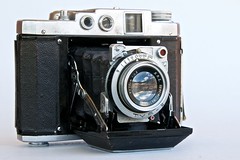 Mamiya Six III |
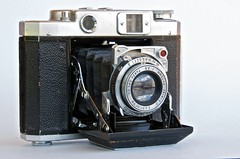 Mamiya Six IV |
Mamiya Six V |
Mamiya Six IVb |
| Mamiya Six IVs |
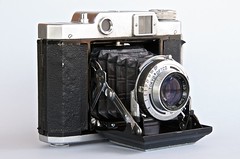 Mamiya Six K |
Mamiya Six K2 |
Mamiya Six P |
| Mamiya Six Automat |
Mamiya Six Automat 2 | ||
| The various models of the Mamiya Six Images by Dirk HR Spennemann. (Image rights) | |||
TEMPLATE CHART
| Mamiya Six Chronology () | |||||||||||||||||||||||||||||||||||||||||
|---|---|---|---|---|---|---|---|---|---|---|---|---|---|---|---|---|---|---|---|---|---|---|---|---|---|---|---|---|---|---|---|---|---|---|---|---|---|---|---|---|---|
| pre-War | World War II | post-War | MIOJ | ||||||||||||||||||||||||||||||||||||||
| 1940 | 1941 | 1942 | 1943 | 1944 | 1945 | 1946 | 1947 | 1948 | 1949 | 1950 | 1951 | 1952 | 1953 | 1954 | 1955 | 1956 | 1957 | 1958 | 1959 | ||||||||||||||||||||||
| Six I | |||||||||||||||||||||||||||||||||||||||||
| Six II | |||||||||||||||||||||||||||||||||||||||||
| Six III | ? | Six III | |||||||||||||||||||||||||||||||||||||||
| Six IV | |||||||||||||||||||||||||||||||||||||||||
[[Category:Navigational templates|Template:Mamiya Six]]
Dichotomous Key to aid identification of models
The Mamiya Six comes in a bewildering range of variants. The interactive, dichotomous key provided below provides an avenue at identifying the types of Mamiya Six. Once you have identified your model, click on the model name to be taken to a full description. If you are unclear about any of the criteria, either click on the criterion name or jump to this page for visual identification guides.
| Use this interactive key to help identify your Mamiya Six model | ||||||||||||||||||||||||||||||||||||||||||||||||||||||||||||||
| How many viewfinder windows are on the front? | ||||||||||||||||||||||||||||||||||||||||||||||||||||||||||||||
| ||||||||||||||||||||||||||||||||||||||||||||||||||||||||||||||
| ||||||||||||||||||||||||||||||||||||||||||||||||||||||||||||||
Patent Applications
 | 
|
 | 
|
| Illustrations accompanying Seiichi Mamiya's Japanese Utility Model (Patent) application for the Mamiya Six focussing system [8] Images by rebollo_fr. (Image rights) | |
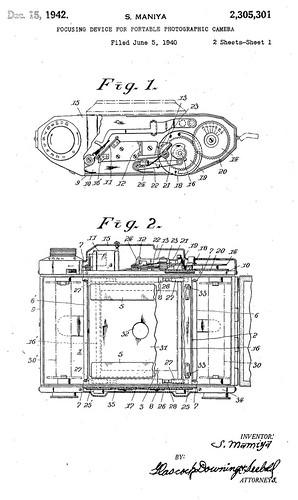 |
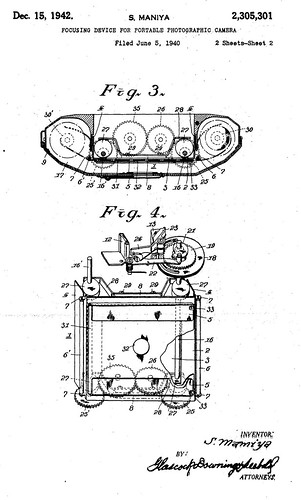 |
| Illustrations accompanying Seiichi Mamiya's U.S. Patent application[9] for the Mamiya Six focussing system Images by Dirk HR Spennemann. (Image rights) | |
Notes
- ↑ Mamiya. A History of Innovation. Mamiya 50th Anniversary. Produced by the Mamiya-History of Innovation Editorial Committee. Bunkyo-ku, Tokyo: Mamiya Camera Co. Ltd. p.
- ↑ Seiichi Mamiya had field an earlier application with the British Patent Office (for an improvement in single lens reflex cameras) again emphasising the need to be bale to maintain control when focussing. While that application was successful, the patent was not granted as Mamiya failed to pay the sealing fee: "Improvements In Or Relating To Photographic Cameras. Patent GB326688. Filed 17 April 1929; Published 20 March 1930.[| GB-Patent-326688/]
- ↑ Japanese utility model publication (実用新案出現広告) no.S15-14673. Applied for (出現) on Jul. 1, 1939 and published (公告) on Oct. 5, 1940.
- ↑ Improvements In And Relating To Focusing Devices For Portable Photographic Cameras. Patent GB542016. Filed ¶¶. Published 22 December 1941.
- ↑ Focussing Device for Portable Photographic Cameras. Patent application by Seiichi Mamiya, Ohita, Takata-Gun, Japan. Filed 5 June 1940, granted 15 December 1942. U.S. Patent nº 2,305,301.
- ↑ According to the official Mamiya history website | History of Mamiya Six (Mamiya history website)
- ↑ See the lens chronology on the Zuiko page.
- ↑ Japanese utility model publication (実用新案出現広告) no.S15-14673. Applied for (出現) on Jul. 1, 1939 and published (公告) on Oct. 5, 1940.
- ↑ Focussing Device for Portable Photographic Cameras. Patent application by Seiichi Mamiya, Ohita, Takata-Gun, Japan. Filed 5 June 1940, granted 15 December 1942. U.S. Patent nº 2,305,301.
PAGE THREE -- Mamiya Six II
The camera was introduced in 1941 and sold for ¥384.[1] [2] Even though numbered Mamiya II, this is in fact the third model to have been introduced. Like the Mamiya Six Ia, this model has a red double exposure warning pane in the rangefinder window. The Mamiya Six II is essentially a Mamiya Six III design without the flash contacts. At least some of the units seen also lack the red double-exposure warning pane in the rangefinder. Thus, in common it also has the slightly smaller waist level viewfinder (10 x 10 mm) and a smooth rim to the central viewfinder window.
The production of Mamiya Six II models alongside the Mamiya Six III seems to have resumed in mid 1946 or early 1947. The price control list of 25 August 1947[3] includes the Mamiya Six II at a retail price of ¥8540[4] Less than a month later the price was set at ¥12220.[5]
Technical details
- Like the Mamiya Six III from which this model is derived, the Six II has a smaller waist level finder (10 x10 mm) and the dimpled shutter release button. The guide rail for the removable pressure plate runs for the length of the film gate and now exhibits an embossed directional arrow.
Dimensions
- 145 x 107 x 53mm (105mm open); 783g [6]
Lens and shutter combinations

|
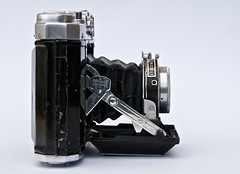
|
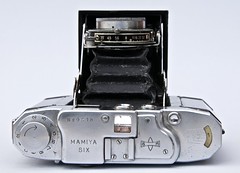
|
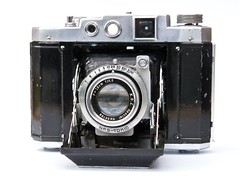
|
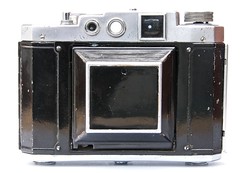
|
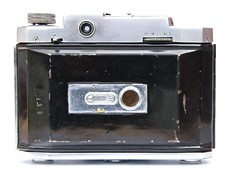
|
| Mamiya Six Model II sn#9518 with a K.O.L. Special 75mm f/3.5 in NKS–TOKIO '0' shutter with T, B, 1-1/200 sec. Images by Dirk HR Spennemann. (Image rights) | ||
Mamiya Six IIa
As with the Mamiya Ia, this version of the Mamiya II allowed to use the larger (type '0', 58mm) shutters, which required to use a simplified two-strut mechanism for the front door. This version was designed for photographers who wished to have faster (and thus usually larger diameter) shutters or have their own shutter and lens combinations installed.[9]
Dimensions
- 145 x 108 x 53 mm closed (105mm open); weight:827g[10]
Lens and shutter combinations
- K.O.L. Special f/3.5 75mm
- in WESTER-MODEL-I shutter (T, B, 1-200th)[11]
- T.S.M. Anastigmat f/3.5 75mm
- Carl Zeiss Jena Tessar f/2.8 7.5cm

|

|

|
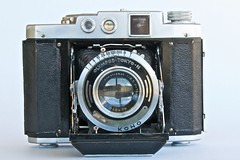
|
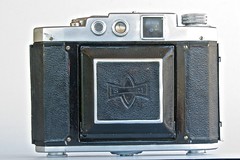
|

|
| Mamiya Six Model IIa sn# 22344 with T.S.M. Anastigmat f/3.5 75mm in OLYMPUS-TOKYO-N KOHO shutter (B, T, 1-200th). Images by Dirk HR Spennemann. (Image rights) | ||
Brochures and Manuals
| http://XXXX.jpg | http://XXXX.jpg | http://XXXX.jpg | http://XXXX.jpg |
| 'War-Time 'Advertising Brochure' (selective pages only) Images by Dirk HR Spennemann. (Image rights) | |||
Notes
- ↑ Mamiya. A History of Innovation. Mamiya 50th Anniversary. Produced by the Mamiya-History of Innovation Editorial Committee. Bunkyo-ku, Tokyo: Mamiya Camera Co. Ltd. p.4
- ↑ Asahi Camera ¶¶¶¶¶ | Neco's Mamiya site
- ↑ The US authorities managing in post-war Japan set up a price control system that regulated not only how much manufacturers could charge for their products but also the resulting wholesale (5.5% mark-up) and retail prices (additional 15.6-15.8% mark up).
- ↑ The ex factory price was ¥7000, with the whole sale price ¥7385. Director General of the Price Board Wada Hiroo. Controlled Prices for home-made [= domestic production, Ed.] camera and its accessory (abolishes Minustry of Finance Notification nº 467 of June 1946). Price Board Notification No. 494 of 25 August 1947. Official Gazette (English Version) nº 421, 25 August 1947, pp. 6-8.[Tokyo: Government Printing Bureau].
- ↑ The ex factory price was ¥10020, with the whole sale price ¥10571. Director General of the Price Board Wada Hiroo. Controlled Prices for home-made [= domestic production, Ed.] camera and its accessory (abolishes Price Board Notification nº 494 of August 1947). Price Board Notification No. 554 of 3 September 1947. Official Gazette (English Version) nº 429, 3 September 1946, pp. 2-4.[Tokyo: Government Printing Bureau].
- ↑ With a K.O.L. Special 75mm f3.5 in NKS–TOKIO '0' shutter with T, B, 1-1/200 sec
- ↑ sn# 9518.—Photographica Collection Dirk HR Spennemann | (Flickr image).—Also illustrated on the back panel of a Brochure (1943?) on the Mamiya Six III
- ↑ sn#19513—Photographica Collection Dirk HR Spennemann
- ↑ Mamiya History Pages, | Mamiya Six IIa
- ↑ With a T.S.M. Anastigmat f/3.5 75mm in OLYMPUS-TOKYO-N KOHO shutter (B, T, 1-200th)
- ↑ Illustrated on the back panel of a Brochure (1943?) on the Mamiya Six III
- ↑ sn#22344—Photographica Collection Dirk HR Spennemann
- ↑ | Neco's Mamiya Site
PAGE FIVE -- Mamiya Six IV
The camera was introduced in the fourth quarter of 1947.[1] The Mamiya Six IV was a major redesign of the camera, dispensing with the small waist-level viewfinder. That space was taken up by a newly designed range-finder mechanism, which had been developed by Mamiya in March 1947.[2]
As part of the export drive tightly managed by the U.S. administration,[3].Mamiya cameras were sold overseas in large quantities[4] and less so on the domestic market[5] In September 1948 Mamiya reputedly ranked as top exporter of the Japanese camera industry.[6] One major contract, signed in December 1948, was the manufacture of Mamiya Six IV models for the Indian distributor Patel, who sold these units badged as CAMEX Six.[7]. These orders and the steady growth of the export market saw the monthly production of Mamiya Six IV models rise from 600 units per month in November 1950 to 1,500 units in March 1953.[8]
The camera was sold in Japan for ¥ ¶¶¶.[9] A certain black-market trade (by servicemen stationed in Japan) seems to have existed in countries where formal imports did not occur until later.[10] It is listed in Australia for £24 10s in 1952[11] and the USA for $99.95 in 1954[12]
Technical details
- TEXT TEXT TEXT
- The top of the camera housing has retained the same curved shape as that of the Mamiya Six III, but the redesign of the rangefinder saw Mamiya dispensing with the small Brillant-type waist level viewfinder. as a result, the front housing has only two windows, a square viewfinder window, which is surrounded by a small rectangular plate, and the small round rangefinder control window.
- In keeping with the directives of the U.S. administration of Japan, Mamiya cameras produced between 1947 and 1949 were marked " Made in Occupied Japan." The early variants had this statement prominently engraved into bottom of the metal housing, but the later production was allowed to use text embossed into the leather covering of the door catch.[13]
Variant A
- The inscription "Made in Occupied Japan" is engraved on the bottom plate.
Variant B
- The inscription "Made in Occupied Japan" is embossed into the leatherette of the door closing mechanism..
Variant C
- The camera no longer exhibits any reference to "Made in Occupied Japan".
CAMEX Six
- In December 1948 Mamiya signed a major export order with the Indian distributor Patel.[14] A large number of custom-badged Mamiya Six IV were produced,[15] carrying on the top housing the engraving "CAMEX SIX PATEL INDIA LTD" instead of the standard 'MAMIYA-6.' In every other aspect these Indian export models are build-identical with standard Six IV models and retain the Mamiya logo both (engraved) on the top housing and (embossed) on the front door.[16]
Dimensions
- TEXT TEXT TEXT
Lens and shutter combinations
- Novar Anastigmat f/3.5 75mm
- Olympus D Zuiko F.C. f/3.5 75mm
- Olympus Zuiko C f/3.5 75mm
- Olympus Zuiko Coated f/3.5 75mm
- Olympus Zuiko F.C. f/3.5 75mm
- Setagaya Kōki Sekor T f/3.5 75mm (silver face)
- Takatiho Tokio Zuiko f/3.5 75mm
- Tokyo Opt. Co. C. Simlar f/3.5 75mm
Variant A
Variant B
Variant C
CAMEX Six
- Minolta Rokkor 75mm f/3.5
- Olympus Zuiko Coated f/3.5 75mm
- Takatiho Tokio Zuiko f/3.5 75mm
- Carl Zeiss Jena f/3.5 75mm
  
|
  
|
| Mamiya Six IV no.35446, Zuiko 7.5cm f/3.5 lens no.38265. Pictures courtesy of Adrian Gotts. (Image rights) |
Advertisements
 Ars Camera May 1948 |
 Asahi Camera (アサヒカメラ) Camera May 1950 |
 Asahi Camera (アサヒカメラ) June 1950 |
 Asahi Camera (アサヒカメラ) Aug 1950 |
 Photo Art (フォトアー) Jan 1951 |
 Asahi Camera (アサヒカメラ) Mar 1951 |
 Asahi Camera (アサヒカメラ) Jul 1951 |
 Asahi Camera (アサヒカメラ) March 1952 |
| http://XXXX.jpg | http://XXXX.jpg | http://XXXX.jpg | |
| Post-War advertisements for the Mamiya Six IV Images by Rebollo_fr. (Image rights) | |||
Patent Application
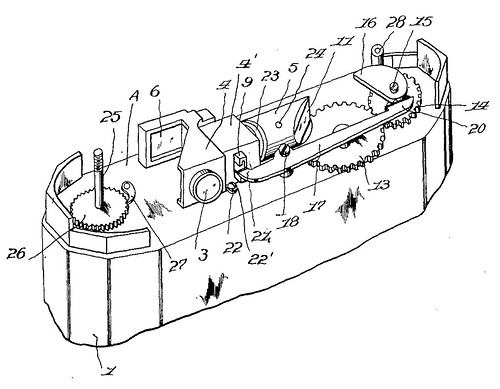 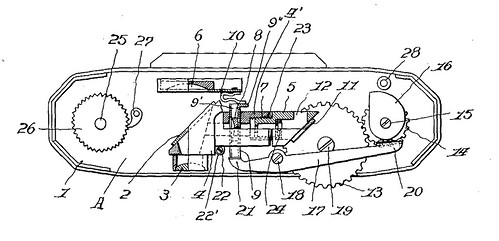
|
http://TEXT.jpg |
| Redesigned rangefinder of the Mamiya Six. US Patent US 2,808,770 (left) and actual example (right) Images by Dirk HR Spennemann (Image rights) | |
Notes
- ↑ Asahi Camera ¶¶¶¶¶ Neco's Mamiya page.—The Mamiya Six IV is not listed in the Price Board Notification nº 554 of 3 September 1947 (Official Gazette-English Edition [Tokyo: Government Printing Bureau] nº 429, 3 September 1946, pp. 2-4).
- ↑ Mamiya. A History of Innovation. Mamiya 50th Anniversary. Produced by the Mamiya-History of Innovation Editorial Committee. Bunkyo-ku, Tokyo: Mamiya Camera Co. Ltd. p. 5.
- ↑ Japanese camera manufacturers were gradually allowed to trade freely with overseas countries. For example, unregulated export to the U.S.A, France, India and Hong Kong commenced in August 1947 (Mamiya. A History of Innovation. Mamiya 50th Anniversary. Produced by the Mamiya-History of Innovation Editorial Committee. Bunkyo-ku, Tokyo: Mamiya Camera Co. Ltd. p. 5).
- ↑ For example, the first order to Hawai'i was shipped in April 1948 and to Canada in November 1949. The European market (Italy, Switzerland) was opened up by April 1950 (Mamiya. A History of Innovation. Mamiya 50th Anniversary. Produced by the Mamiya-History of Innovation Editorial Committee. Bunkyo-ku, Tokyo: Mamiya Camera Co. Ltd. p. 5-6).
- ↑ Unlike with the early Konica I models, we have only very few Mamiya Six copies with an engraved CPO [Central Purchasing Office] mark. Yet, the Mamiya company history notes that by April 1949 business with the PX system was thriving. It is possible that by the then CPO marking had been abandoned. (Mamiya. A History of Innovation. Mamiya 50th Anniversary. Produced by the Mamiya-History of Innovation Editorial Committee. Bunkyo-ku, Tokyo: Mamiya Camera Co. Ltd. p. 5).
- ↑ Mamiya. A History of Innovation. Mamiya 50th Anniversary. Produced by the Mamiya-History of Innovation Editorial Committee. Bunkyo-ku, Tokyo: Mamiya Camera Co. Ltd. p. 5.
- ↑ Mamiya. A History of Innovation. Mamiya 50th Anniversary. Produced by the Mamiya-History of Innovation Editorial Committee. Bunkyo-ku, Tokyo: Mamiya Camera Co. Ltd. p. 5.
- ↑ Mamiya. A History of Innovation. Mamiya 50th Anniversary. Produced by the Mamiya-History of Innovation Editorial Committee. Bunkyo-ku, Tokyo: Mamiya Camera Co. Ltd. p. 6.
- ↑ ¶¶¶
- ↑ Mamiya IV (or III?) were sold on the private market in Australia, probably as bring-back items by servicemen stationed in post-World War II Japan. In 1948, the going price seems to have been £50 in both Sydney and Melbourne: Advertising 'Wanted to sell’ The Sydney Morning Herald 13 March 1948 p 13 (private advertisement) with Zeiss Tessar in Compur Shutter £50.—Advertising 'Wanted to sell’ The Argus (Melbourne) 11 February 1948 p 11 col. 2 (private advertisement) £50.
- ↑ Classified Advertising ‘Goodman Bros, Sydney’ The Sydney Morning Herald 10 May 1952 p 14 £24/10/
- ↑ Sales price in the USA in 1954: Mamiya IV with Olympus D Zuiko F.C. f/3.5 (black face) $99.95; Auto-up $18.95; Flash $19.95 (The Complete Photo Equipment Guide. U.S. Camera November 1954, p. 89 file
- ↑ The same, for example, was required on the early Konica I models. But Konica had the statement prominently engraved on the top housing. (see [| this photo].
- ↑ Mamiya. A History of Innovation. Mamiya 50th Anniversary. Produced by the Mamiya-History of Innovation Editorial Committee. Bunkyo-ku, Tokyo: Mamiya Camera Co. Ltd. p. 4.
- ↑ The total number of Mamiya Six IV badged as 'CAMEX' is unclear at the time of writing. Preliminary searches have so far identified the following serial numbers: 41520, 43015, 43043, 43076 and 43122. Because standard versions of the Mamiya Six IV exist with serial numbers in the 42xxx range, it is possible that Mamiya filled at least two orders to India.
- ↑ See images in Sylvian Halgand's site
- ↑ [[ http://www.pbase.com/nickdemarco/image/122732832%7CWeb page]]
- ↑ [[ http://page5.auctions.yahoo.co.jp/jp/auction/e105826102%7CYahoo Auction, seen December 2010]]
- ↑ [[ http://www.pbase.com/jypsee/oldcameras%7CWeb page]]
- ↑ sn#49068—Photographica Collection Dirk HR Spennemann
- ↑ [[ http://www.flickr.com/photos/yefeihe/4909210453/%7CFlickr image]]
- ↑ [[ http://photo.net/medium-format-photography-forum/00H92u%7CWeb page]]
- ↑ sn#71295—Photographica Collection Dirk HR Spennemann
- ↑ [[ http://ota-euphony.sakura.ne.jp/?page_id=78%7CWeb page]]
- ↑ [[ http://page9.auctions.yahoo.co.jp/jp/auction/k135303419%7CYahoo Auction, seen December 2010]]
- ↑ [[ http://www.flickr.com/photos/rebollo_fr/2448145013/in/pool-camerapedia/%7CFlickr image]]
- ↑ sn#36632—Photographica Collection Dirk HR Spennemann
- ↑ Collection Sylvain Halgand
- ↑ sn 43043 Christies] Sale 9298 (London, South Kensington, 19 February 2002) Lot 442
- ↑ sn 41520 Photographica Auctions Photo Rahn 9 May 2010, Photographica Auction 12 Lot 559
- ↑ private colelction, via e-mail
PAGE SIX -- Mamiya Six V
November 1953 Mamiya 6-V Dual format (6x4.5cm and 6x6cm) with automatic film winding adjustment. Maximum shutter speed improved to 1/500 sec.
Technical details
- TEXT TEXT TEXT
Dimensions
- TEXT TEXT TEXT
Lens and shutter combinations
- Kowa Optical Works Prominar f/3.5 75mm
- Olympus D Zuiko F.C. f/3.5 75mm
- Olympus Zuiko F.C. f/3.5 75mm
Notes
PAGE SEVEN -- Mamiya Six K
The Mamiya Six-K was introduced in August 1954 as a popular, lower priced version of Mamiya 6-V. It lacks not only the automatic film winding stop but also lacks the red double exposure warning pane in the viewfinder, which had been a characteristic of the earlier models.
Technical details
The front range finder windows of the Mamiya Six-K resemble those of the Mamiya IV (a round window at the left and a rectangular window on the right, surrounded by a small screwed-on frame). the margins of the frame of the Mamiya Six K are narrower than those of the Mamiya IV.[1] The name tag of the camera is ¶¶¶ The catch for the film door opens upwards, rather than downwards as was the case with the earlier Mamiya Six models.
Dimensions
- TEXT TEXT TEXT
Lens and shutter combinations
- Setagaya Kōki Sekor T f/3.5 75mm (silver face)
- Tokyo Opt. Co Toko f/3.5 75mm (black face)
- in TOKYO OPT CO-badged RECTUS (B, T, 1-200th) shutter[4]
Notes
- ↑ The design has been taken from the Mamiya IV as the Mamiya V has a long a long plate supporting BOTH the circular and the rectangular window.
- ↑ [[ http://neco.aki.gs/neco99/neco30/00/mamiya/031223.html |Neco's Mamiya Site]]
- ↑ [[ http://neco.aki.gs/neco99/neco30/00/mamiya/031224.html |Neco's Mamiya Site]]
- ↑ sn#9616—Photographica Collection Dirk HR Spennemann.—The Lens and shutter combination on the unit is somewhat unusual. The Combination of Toko f/3.5 75mm with Tōkyō Kōgaku RECTUS shutter can be found on the [PrimoFlex IB]. Until more units with this shutter combination come to light, we may have to assume that this is a post-market custom modification.
PAGE EIGHT -- Mamiya Six IVb
May 1955 Mamiya 6-iV B Camera body size and weight were reduced to increase compactness.
??? new rangefinder in this model??
The design by Seiichi Mamiya was applied in Japan on 23 June 1954 and in the USA on 20 June 1955 (granted 24 June 1958).[1]
Technical details
- TEXT TEXT TEXT
Dimensions
- TEXT TEXT TEXT
Lens and shutter combinations
Notes
- ↑ Camera rangefinder. Patent application by Seiichi Mamiya, Bunkyo-Ku, Tokyo-to, Japan. Filed 12 May 1955, granted 8 October 1957. U.S. Patent nº 2,808,770.
- ↑ [[ http://www.flickr.com/photos/elmoalves/4315236143%7CFlickr image]]
- ↑ [[ http://www.flickr.com/photos/blackfacesheep/5092156263/%7CFlickr image]]
- ↑ [[ http://page2.auctions.yahoo.co.jp/jp/auction/b117574345%7CYahoo Auction, seen December 2010]]
PAGE NINE -- Mamiya Six Automat
The Mamiya Six Automat was released in December 1955. It was the first Japanese camera which automatically cocked the shutter when advancing the film. The design for the automatic shutter cocking device was applied for by Seiichi Mamiya in Japan on 23 June 1954 and in the USA on 20 June 1955 (granted 24 June 1958).[1] On release, the camera was offered for ¥29.500.[2]
Technical details
- TEXT TEXT TEXT
Dimensions
- 140 x 104 x 55 mm (closed); ¶¶¶ (open); weight 850g
Lens and shutter combinations
Patent Application
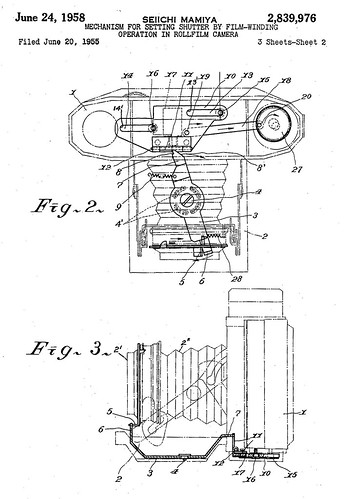 |
 |
| Illustrations accompanying Seiichi Mamiya's Patent application for the Mamiya Six Automat Images by Dirk HR Spennemann. (Image rights) | |
Notes
- ↑ Mechanism for setting shutter by film-winding operation in rollfilm camera. Patent application by Seiichi Mamiya, Bunkyo-Ku, Tokyo-to, Japan. Filed 20 June 1955, granted 24 June 1958 1952. U.S. Patent nº 2,839,976.
- ↑ ¥28,410 for the camera only and ¥1,090 for the leather case (see Mamiya History).
- ↑ A coated four element in three groups lens.
- ↑ [[ http://www.g-root.jp/basement/camera/mamiya6automat.html |Web page]]
PAGE TEN -- Mamiya Six K2
The camera was released in March 1956 with a retail price of ¥19,500.Cite error: Closing </ref> missing for <ref> tag
- Setagaya Kōki Sekor S f/3.5 75mm (black face)
Notes
- ↑ [[ http://poyorin.cocolog-nifty.com/blog/2009/09/index.html |Web page]]
- ↑ [[ http://neco.aki.gs/neco99/neco30/00/mamiya/0312510.html |Neco's Mamiya Site]]
PAGE ELEVEN -- Mamiya Six IVs
October 1957 Mamiya 6-iV S Further reduced size and weight from type iV B with addition of built-in self-timer.
Technical details
- TEXT TEXT TEXT
Dimensions
- TEXT TEXT TEXT
Lens and shutter combinations
Notes
- ↑ [[ http://neco.aki.gs/neco99/neco30/00/mamiya/031212.html |Neco's Mamiya Site]]
{{WIP}
PAGE TWELVE -- Mamiya Six P
December 1957 Mamiya 6-P Economy priced version of 6-iV S.
Technical details
- TEXT TEXT TEXT
Dimensions
- TEXT TEXT TEXT
Lens and shutter combinations
- Mamiya Kominar f/3.5 75mm
- Setagaya Kōki Sekor T f/3.5 75mm (silver face)
Notes
- ↑ [[ http://neco.aki.gs/neco99/neco30/00/mamiya/031212.html |Neco's Mamiya Site]]
- ↑ [[ http://neco.aki.gs/neco99/neco30/00/mamiya/20/p/p0200101.html |Neco's Mamiya Site]]
PAGE THIRTEEN -- Mamiya Six Automat 2
Mamiya 6 Automat 2 was the last iteration of the camera design. It was the most highly featured Mamiya 6 camera with Sekor lens, bright Albada finder and other advanced features. It was introduced in July 1958 at a price of ¥24,000.[1]
Technical details
- TEXT TEXT TEXT
- The finder now includes a brightframe.
Dimensions
- 140 x 104 x 54 mm (closed); ¶¶¶ (open); weight 843g.
Lens and shutter combinations
- Mamiya Sekor f/3.5 75mm
- Olympus D Zuiko F.C. f/3.5 75mm (black face)
Notes
- ↑ ¥22,910 for the camera and ¥1,090 for the leather case (see Mamiya History).
- ↑ [[ http://neco.aki.gs/neco99/neco30/00/mamiya/031264.html |Neco's Mamiya Site]]
- ↑ [[ http://neco.aki.gs/neco99/neco30/00/mamiya/031271.html |Neco's Mamiya Site]]